Abstract
With the development and utilization of resources, mineral-resource cities face the dilemma of resource depletion, the environmental restoration of mines, and industrial transformation. Reusing their mining heritage is a good way for these cities to change their mono-industrial structure and vigorously develop successor industries. Due to the complexity of reusing mining heritage, introducing the “Public–Private-Partnership” (PPP) mode can be a good solution to the problems of the government’s mining heritage reuse, such as large capital investment and a long construction-cycle time. To accurately classify the risk of reuse of mining heritage in the PPP mode, 26 indicators are selected to construct the evaluation index system of mining heritage reuse in the PPP mode based on five aspects: social capital-side, contractor-side, government-side, civilian-side, and the natural environment. The path coefficients of the structural equation model are used to calculate the weights of the indicators. The improved matter–element extension model is constructed to evaluate the reuse of mining heritage in the PPP mode. The Jiaozuo-Centennial Mining Heritage Park project is the object of research for applying the model. The results show that the risk evaluation index system combines the risk factors from the stakeholders’ perspective. The risk-evaluation model of the mining heritage reuse PPP project is constructed based on the combination of the improved matter–element extension model, the calculation of the asymmetric closeness, and the structural equation modeling method, which solves the drawbacks of the traditional model, such as the difficulty of determining the weights of the indicators, the incomplete scope of the material element domains, and the poor calculation of the comprehensive correlation degree. The case analysis shows that the risk level of the Jiaozuo-Centennial Mining Heritage Park project is Level II. This aligns with the actual situation and verifies the feasibility of the risk-evaluation model applied to the actual project. The research in this paper fills the gap in the risk model of mining heritage reuse in the PPP mode, enriches the theoretical system of risk evaluation of mining heritage reuse projects, and provides reference significance for similar mining heritage development projects in the future.
Keywords:
mining heritage; improved matter–element extension model; normalization process; the PPP mode; structural equation model MSC:
91B05
1. Introduction
With the gradual exploitation and depletion of resources, mining-resource cities are generally characterized by many environmental, human employment, and economic decline problems [,]. Reusing mining heritage is a good way to face the problems of urban transformation, changing the industrial structure, and developing successor industries [,]. However, the establishment and implementation of mining heritage reuse projects require a large amount of human and material resources and financial support, and mining enterprises or local governments are often unable to support the construction of the project, requiring the government and other social capital members to join in to bear the costs of the project. After years of development, the PPP mode has gradually begun to emerge in various fields and show its superiority [,,].
Risk evaluation is needed before implementing the project based on the characteristics of mining heritage reuse, such as high investment levels, a long period of time, and wide involvement [,]. Ameyaw, E.E. et al. used literature research and case study methodology and contacted practitioners in the industry to conduct a comprehensive questionnaire survey on water-supply PPP projects, which resulted in three types of risk factor []. Heravi, G. et al. harmonized risk into seven categories based on their characteristics, such as political risk, market risk, operational risk, and force majeure risk []. Shen, L.Y. et al. categorized the risks of PPP projects into 13 major categories from three dimensions: external, internal, and project-level []. Ng, A. et al. categorized the risks of PPP projects into general and specific risks based on whether there is a connection between the risks and the project subject [].
Matter–element extension is an evaluation method mainly used to resolve the incompatibility of functional objectives with environmental conditions [,,]. It is suitable for multifactor assessment [], and compared with traditional evaluation methods, the matter–element extension method is more scientific and reasonable in dealing with incompatibility []. The numerous contradictory problems inherent in projects in the mining heritage reuse field cause incompatibility between the risk-evaluation indicators of PPP projects. Risk indicators are incompatible and independent when carrying out risk factor identification. It is extremely appropriate to use the matter–element extension method for risk evaluation [,]. Still, the matter–element extension method also has a certain degree of self-limitation, which acts directly on the risk-evaluation system. This will have a certain adverse effect on the analysis results.
Therefore, some improvements need to be made to the classical matter–element extension model for it to be more accurate for risk evaluation. Yun-Na, W. et al. applied the matter–element extension method and its improved version to evaluate hybrid renewable sites []. Wang, Q. et al. improved the matter–element extension model to assess the sustainability of the water–energy–food nexus []. Wang, Y.L. et al. evaluated the demand response of an integrated regional energy system based on an improved matter–element extension model []. Liu, S.L. et al. utilized variable weight theory and an improved matter–element extension model to conduct indicator sensitivity analysis of environmental engineering geological patterns related to coal mining [].
The PPP mode has been introduced into the field of mining heritage reuse. Still, there is a relative lack of studies in the literature on the subject, especially on risk identification and evaluation, and the risk-evaluation model of mining heritage reuse in the PPP mode is still missing. A new model of mining heritage reuse in the PPP mode was established based on the improved matter–element extension model to accurately classify the risk level of mining heritage reuse in the PPP mode. By changing the index division and naming mode in general risk-evaluation research, the risk-evaluation index system of the mining heritage reuse PPP project was established from the stakeholders’ perspective. By analyzing the main problems and causes of risks from different perspectives in the project, the main risk factors were identified and condensed to adopt the risk-assessment model based on the improved matter–element extension model and to verify the effectiveness of the assessment method with the example of an urban mining heritage reuse project.
2. Object of Study
Mining heritage encompasses all the historical remnants of mining development associated with extraction. The main components are shown in Figure 1, and the actual picture in Figure 2.

Figure 1.
Key components of the mining heritage.

Figure 2.
These pictures are from the Zijinshan gold–copper mine. Among them are a (a) large open pit mine; (b) open pit mine dump; (c) rehabilitated mining area slopes; and (d) underground mine tunnel. They are in Shanghang County, Longyan City, Fujian Province, China.
From the 1980s onwards, the government gradually became aware of the dangers of mining production on the natural environment [,]. At this time, the development and utilization of mining heritage and research mainly focused on assessing the value of mining heritage, the landscape development of mining heritage, and the tourism development of mining heritage []. For example, the European Route of Industrial Heritage (ERIH) has created distinctive cultural heritage tourism and mining heritage protection systems through the holistic utilization of mining heritage. Research on the protection and development of mining heritage continues to diversify and develop in-depth, providing a new direction for the green transformation of resource cities []. It also opens the door to the transformation of industrial structures and the economic gain of resource cities []. Germany’s “Zollverein Park”, once the largest site for the coal mining industry, has taken full advantage of its mining heritage to create a vibrant recreational area.
Entering the 21st century, the concept of sustainable development and the rise of the low-carbon revolution, the transformation and development of resource-based cities also need to align with these []. How to utilize mining heritage is particularly important at this time []. Research on the preservation and reuse of mining heritage can be categorized into three main approaches: the “recreation mode”, the “education mode”, and the “multi-purpose complex mode”. At the same time that the development and utilization of mining heritage were progressing at a high speed, many problems were also found to exist [], for example, a need for more depth in the development of historical legacy resources, a lack of integration of culture and tourism, a shortage of talents in mining tourism, and a single marketing and revenue model, etc. [].
The mining heritage reuse project is not commercial in a purely traditional sense []. It is related to the green transformation of resource-based cities, sustainable development, and the future development trend of the environmental remediation of mining land, as well as government finance and urban livelihoods []. Based on a century of coal mining history, in Jiaozuo City, Henan Province, China, Jiaozuo-Centennial Mining Heritage Park is a development point for industrial transformation to promote the integrated development of culture, tourism, and creativity, and to inject new impetus and vitality for the high-quality development of the economy.
The PPP mode has significant advantages in transforming and developing mineral resource cities. It constructs a synergistic governance mechanism involving multiple subjects with the government as the core, enterprises as the carrier, and the public’s participation []. It is essential to recognize the inherent risks associated with this novel approach []. Confronting these risks, conducting thorough risk assessments, and proactive monitoring within the framework of the PPP mode for mining heritage reutilization projects becomes imperative. Mining heritage reutilization projects necessitate the safeguarding and restoration of these legacies. Furthermore, therapeutic actions should be taken to rehabilitate the natural environment adversely impacted by resource exploitation. Concurrently, there is a requirement to meticulously unearth cultural heritage, engendering a continuum of industrial culture. This multifaceted approach concludes by cultivating locally rooted industries distinguished by their distinctive competitive advantages.
3. Materials and Methods
3.1. Risk Factor Identification
The PPP mode mining heritage reuse project involves a wide range of risk of a high complexity. This study is based on literature analysis [,,,,,,,,,], following the principles of comprehensiveness, scientificity, objectivity, and feasibility, to screen and extract the risk factors that exist in mining heritage reuse PPP projects, and construct a list of risk factors of mining heritage reuse PPP projects because of current problems in this field. The final risk-factor identification list for the mining heritage reuse PPP project is shown in Table 1 below.

Table 1.
The final risk factor list.
3.2. Establishment of System of Risk-Evaluation Indicators
Through the questionnaire survey of the Likert five-point scale method [], a total of 350 questionnaires were distributed, and 276 questionnaires were recovered at the end of the process, with a recovery rate of 78.9%, and the total final usable questionnaires after removing the invalid questionnaires were 263, with a validity rate of 75.1%. The collected questionnaire data were visualized and analyzed for further descriptive statistical information. The respondents’ education in this survey was a bachelor’s degree or above. From Figure 3, we can see that the main age distribution of participants was 35 to 45 years old, accounting for 66.20%. A total of 47.70% of the people engaged in the research work had more than 5 years of employment in the PPP project, and the people who participated in the questionnaire survey were evenly distributed in the relevant work areas. The basic characteristics of the data proved that the data of this questionnaire survey had a certain degree of rationality and can reliably provide a foundation for further analysis.
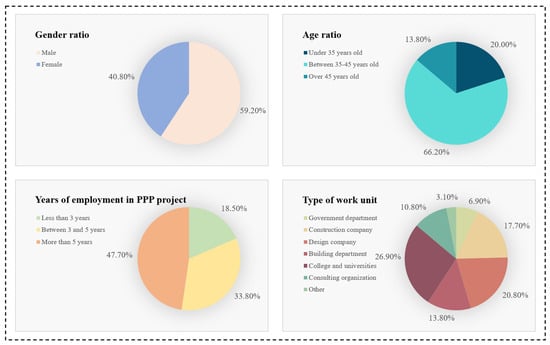
Figure 3.
Statistical data on basic characteristics of respondents.
3.2.1. Reliability Analysis
Cronbach’s α coefficient method is the most widely used and persuasive reliability test method. The value of Cronbach’s α coefficient is between 0~1, and the size of the value has a positive correlation with the reliability of the data. Cronbach’s α coefficient obtained after the calculation was 0.944, which belonged to the range of extremely high reliability, indicating that the questionnaire survey results are valid and have researchability.
3.2.2. Validity Analysis
Validity represents the correctness of the survey scale data and consists of two components: content validity and structural validity. The KMO (Kaiser–Meyer–Olkin) test and Bartletts’ sphericity test were performed on the questionnaire scale data to test the degree of correlation between the variables in the scale. The test results were 0.942 for the KMO test and 0.000 for Bartletts’ test of sphericity, which was much smaller than the standardized value of 0.05. The combined results of the above two tests proved that the questionnaire data had a strong correlation and were suitable for factor analysis.
3.2.3. Exploratory Factor Analysis
Through principal component analysis, the risk factors with eigenvalues greater than 1 were selected as the public factors, and the maximum variance method was finally used to extract the five public factors. Through the total variance interpretation, it can be seen that the cumulative total contribution rate of the five public factors with eigenvalues greater than 1 was 74.579%, which was more than 70%, proving that these five public factors represent most of the information of the data of this measurement scale, can better respond to the information reflected by the original index and have a good differentiation validity. At the same time, it can be found that the change of the folding line in Figure 4 gradually slows down and remains level from the sixth point onwards.
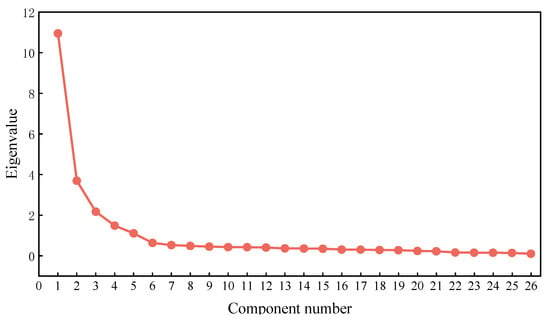
Figure 4.
Plot of initial eigenvalue totals in total variance interpretation.
3.2.4. Naming of Public Factors
The risk level indicators in the risk-evaluation index system were mostly categorized by the environment in which the risk occurs, and through the exploratory factor analysis mentioned above, it was found that the extracted public factors were more biased toward the risks borne by each stakeholder, so this study enlisted each stakeholder to name the public factors. The naming and classification of public factors are shown in Table 2.

Table 2.
Naming and classification of public factors.
3.2.5. Risk Evaluation Indicator System
According to the results of factor analysis and the naming of public factors, the risk evaluation index system of the mining heritage reuse PPP project is shown in Table 3 below.

Table 3.
The mining heritage reuse in the PPP mode evaluation index system.
3.3. Risk-Evaluation Model Weight
The factor loadings of each order were obtained by analyzing the runs of their individual paths through structural equation modeling. In the case of a significant p-value, the normalized factor loadings were regarded as the correlation coefficient (path coefficient) between two factors, which reflects the degree of correlation between the indicators.
The five interacting potential variables were “Government-side risk”, “Social capital-side risk”, “Contractor-side risk”, “Civilian-side risk”, and “Natural environment risk”, and the relationship between them was constructed into a five-factor second-order SEM model of the risk influencing factors on mining heritage reuse PPP projects, as shown in Figure 5, and the data from the questionnaire was substituted for simulation.
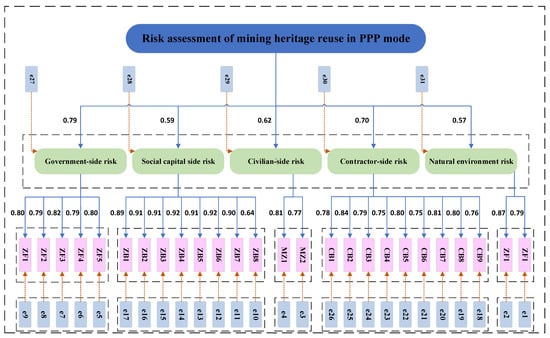
Figure 5.
Five-factor second-order structural equation modeling, where ) is denoted as the residual of the structural model equation.
After observing the path coefficients on the paths in the model, it was found that the data were all positive, which proves that there is a positive correlation between the risk factors, the model can operate normally, and there is no abnormality in the direction of the role of each variable or the coefficient of the role of each variable.
According to the model diagram constructed in Figure 5, the calculation was carried out to obtain the overall fitness index of the structural equation model and the degree of superiority of this SEM model, according to the range of values of different indexes, compared with the calculated values of this model. The comparison in Table 4 shows that all the indicators of the SEM equations constructed in this paper met the fitness criteria.

Table 4.
SEM fit index.
This SEM model of the risk influencing factors of the mining heritage reuse PPP project was established and fit well, while the first-level path was significant in the path’s hypothesis-relationship test in this study, such as in the following: (MZ: β = 0.621, p < 0.001; ZB: β = 0.594, p < 0.001; ZF: β = 0.785, p < 0.001; CB: β = 0.703, p < 0.001; ZR: β = 0.573, p < 0.001). The second-order paths were the same as the above analysis: the p-value was less than 0.001, and all paths satisfied the basic threshold of the significant p-value. Therefore, the weight of each first-order latent variable and second-order observational variable indicator can be calculated based on the path coefficients of the structural equation modeling.
The weight of each indicator W was the ratio of the path coefficient of each order indicator to the sum of the path coefficients of each order. The results of the calculations are shown in Table 5 and Figure 6.

Table 5.
Summary of weights of risk-assessment indicators.
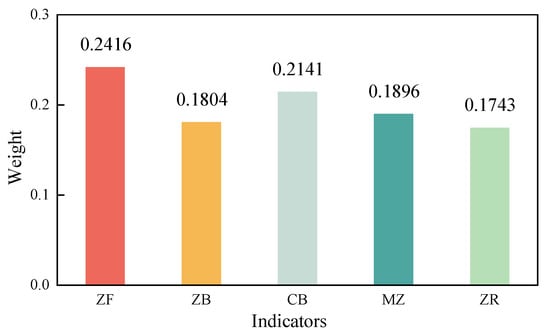
Figure 6.
Ratio of weights assigned to level 1 indicators.
3.4. Basic Principles of Improved Matter–Element Extension Model
The matter–element extension model is a mathematical model based on matter–element theory and extension mathematics []. In 1983, Cai established the theory of matter–element extension and applied a formal model to study the fundamentals of matter extension, which takes the matter–element as the basic element of the description of the object [,]. The matter element is represented as an ordered triple , where denotes the object, denotes a feature of the object, and denotes the amount of corresponding to . Based on the theory of extension sets and the theory of decision making, the decision making problem is investigated with the object element transformation and the correlation function as tools. The extension engineering method can be used to solve application problems in the fields of management, control, and engineering [].
Due to the matter–element extension model having self-limiting problems, such as the fact that weights of each index are not easy to obtain, the scope of the matter–element nodal domain was not comprehensive, and the comprehensive correlation calculation could be better. The method of normalizing the range of quantity value was adopted to avoid the problem of an incomplete range of the matter–element nodal domain. The calculation of asymmetric closeness was used to correct the inaccuracy of the maximum affiliation principle and solve the problem of the unsatisfactory calculation of the comprehensive correlation degree.
3.4.1. Matter Elements, Classical Domains, and Nodal Domains
The matter–element to be evaluated:
The classical domain of evaluation object about grade j is recorded as :
The feature section of the evaluation object is recorded as :
where is the evaluation object. is the eigenvalue of the evaluation object; is the evaluation object corresponding to level , (). is the eigenvalue of the evaluation object, (). is the range of eigenvalues of corresponding to . denotes the lower limit of the classical domain and denotes the upper limit of the classical domain, (). is the evaluation object corresponding to each level. is the range of eigenvalues of corresponding to . denotes the lower limit of the nodal domain. denotes the upper limit of the nodal domain. ().
The improved matter–element extension model needs to normalize the classical domain and nodal domain in the traditional model; that is, it needs to divide both ends of the value of the classical domain by the value of the value range of each index nodal domain at the same time to obtain a new classical matter–element matrix :
The new matter element matrix is constructed by normalizing the quantity value in the original matter element matrix and dividing it by the right endpoint value in the value range of each index nodal domain .
3.4.2. Calculate the Correlation Coefficient and Correlation Degree
The correlation function of the risk level evaluation index of the mining heritage reuse in the PPP mode is defined as
In Equation (6)
where represents the distance between point and the classical domain interval of the matter–element . represents the distance between point and segment interval of object element . denotes the lower limit of the classical domains after the normalization process. denotes the upper limit of the classical domains after the normalization process.
3.4.3. Calculate the Comprehensive Correlative Degree and Determine the Evaluation Level
Based on the normalization process, the asymmetric closeness function is incorporated into the matter–element extension model after the normalization process. The closeness function between the risk factors is assessed, and each risk level is established to circumvent the deficiencies in the original model and achieve the purpose of optimizing the model.
The closeness of each evaluation level is calculated by applying the asymmetric closeness function calculation to the matter–element extension model after the normalization process corresponding to the matter–element to be evaluated, obtained as
where is the close degree of the matter–element corresponding to the evaluation grade . is the number of evaluation indicators.
Based on , it is determined that the risk level belongs to level . The computational process for evaluating mining heritage reuse in the PPP mode using the improved matter–element extension model is shown in Figure 7.
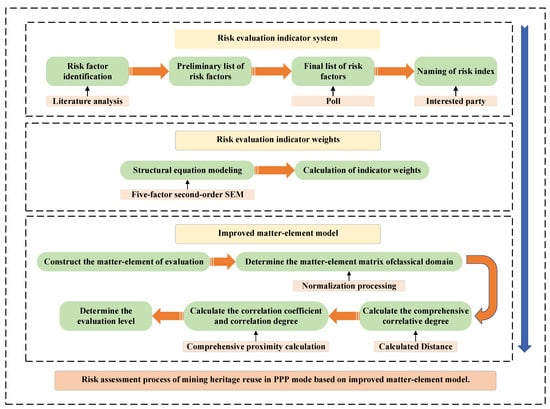
Figure 7.
Risk-assessment process of mining heritage reuse in the PPP mode based on improved matter–element model.
4. Case Study in PPP Mode of Mining Heritage Reuse Project
4.1. Project Background
Jiaozuo City, Henan Province is a famous “century-old coal city” and “old industrial base”. The history of coal mining is more than a century old, and the coal reserves have decreased from more than 9 billion tons to the current 500–600 million tons. The Jiaozuo-Centennial Mining Heritage Park project plans to invest 950 million yuan, and cover an area of about 18.67 hectares, with a total construction area of 53,000 square meters.
The project is divided into two phases. The first phase is protective development. The main construction facilities and venues are a hundred-years-of-mining museum, mining-scene reenactment, and the maintenance of the mine road, etc. The second phase of development is mainly for the expansion of the development, the completion of construction of the mining research and learning experience center, the exclusive experience of the students, and other course characteristics. The project is currently in the construction phase of the first phase of the project. Adopting the PPP mode for this project can reduce the financial pressure on the local government and provide a good model for the protection and utilization of mining heritage and industrial heritage. The mining heritage reuse PPP project operation is shown in Figure 8.
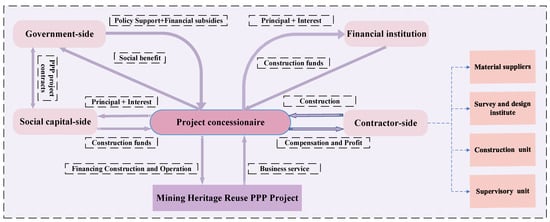
Figure 8.
Mining heritage reuse PPP project operation.
4.2. Project Risk Evaluation
The risk level of the mining resources reuse PPP project is defined as level I (lowest), level V (highest), and a total of five levels, as shown in Figure 9. In this paper, the nodal domain of the project’s risk level to be evaluated was set as [0,10]. The nodal domain was equally divided into 5 points, each representing the risk to be evaluated in the risk level of the classic domain interval value to obtain the range of values of each risk level.

Figure 9.
Risk level of mining heritage reuse.
In this research, 10 experts and 10 postgraduate students related to the field of the project were to be evaluated were selected to score the risk-evaluation indicators of this mining heritage reuse project. Then, the average value of each risk indicator score was calculated based on the collected questionnaires. The score indicated the impact degree of the risk, and the evaluation results are shown in Figure 10.
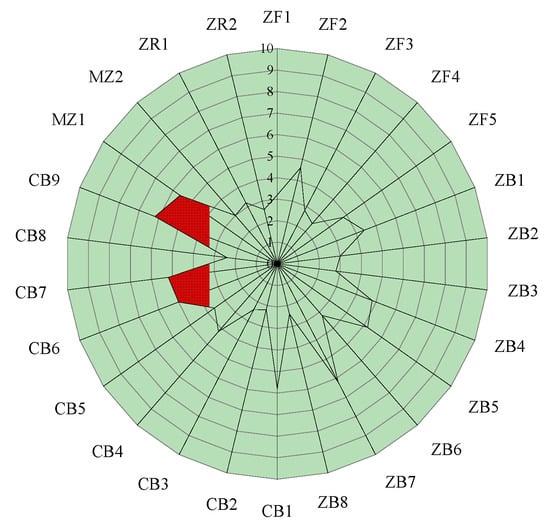
Figure 10.
Jiaozuo-Centennial Mining Heritage Park project risk-indicator-evaluation average value; data from the questionnaire survey.
According to the average value of the risk-evaluation index, the matter element matrix to be evaluated was determined and normalized:
Through Equations (8)–(10), the distances from the 26 risk evaluation indicators of the Jiaozuo-Centennial Mining Heritage Park project to the corresponding evaluation level were calculated. Specific calculations are shown in Table 6 below.

Table 6.
Jiaozuo-Centennial Mining Heritage Park project risk factors about risk-level distance.
The risk-evaluation system of the mining heritage reuse PPP project constructed in this paper was matched with the Jiaozuo-Centennial Mining Heritage Park project, and the weights of each risk factor determined were directly substituted into this example item for calculation. After calculation, it was found that there was a close connection between the risk factors of the Jiaozuo-Centennial Mining Heritage Park project and the evaluation grade. Equation (11) calculates the proximity between the indicators, and the results are listed in Table 7 below.

Table 7.
Jiaozuo-Centennial Mining Heritage Park project: proximity of objects to be evaluated to risk levels.
According to , the risk level of the Jiaozuo-Centennial Mining Heritage Park project was determined to be level II; the risk level of the government-side risk, the civilian-side risk, and the natural environment risk were level Ⅱ; and the risk level of the contractor-side risk and the social capital-side risk were level Ⅲ.
5. Discussion
Risk management is a complex systematic project. Risk evaluation identifies risk factors and reduces risk levels to ensure the stability of mining heritage projects. In the mining heritage reuse in the PPP mode of existing research, the risk identification [] and risk evaluation [] work was less, and the evaluation model was missing. This paper has demonstrated the reliability of the risk model for mining heritage reuse in the PPP mode, based on the improved matter–element extension model, through the Jiaozuo-Centennial Mining Heritage Park case study.
According to the case study results, the risk-evaluation level of the Jiaozuo-Centennial Mining Heritage Park project was level 2. It can be observed that the risk level of the project is low. This conclusion is consistent with actual engineering projects currently in operation, thus verifying the applicability of the risk-evaluation index system constructed in this paper in real engineering.
After analyzing the indicators at the first level, it can be concluded that the social capital-side bore the greatest risk. The contractor-side, the government-side, and the civilian-side risk were in a decreasing order of risk. The natural environment risk had the lowest level of risk. This analysis reveals that problems with social capital aspects during project implementation may have the greatest impact on construction. By maintaining close cooperation and coordination with other relevant parties, such as the government, potential problems can be better anticipated, avoided, and resolved, thus ensuring that the project runs smoothly and on schedule. In addition, the results are a reminder of the importance of the contractor-side risk and the concerns of the civilian-based risks. Although their level of risk was relatively low in the risk evaluation, the people’s opinions and feedback are equally crucial in environmental projects. Through transparent communication and active participation, potential conflicts and controversies can be avoided, and the social sustainability of the project can be enhanced. After analyzing the secondary indicators, several prominent risks can be noted, including the supervision and management risk, the innovation-deficit risk, the security risk, and the profit-return risk. In response to these risks, a series of measures can be taken to establish a dynamic supervision and management mechanism for the whole life cycle of PPP projects, emphasize the cultivation and absorption of comprehensive talents related to PPP projects, and explore a series of measures for more rewarding and profitable ways to reuse mining heritage, to prevent potential risky incidents and ensure the sustainable and successful implementation of projects.
The mining heritage reuse in a PPP mode, based on the improved matter–element model in the field of mining heritage reuse, has the value of practical applicability, helps to ensure the smooth progress of the project, and provides valuable experience for similar projects in risk control. This evaluation system can provide targeted risk assessment for actual projects and practical reference experience for future mining heritage reuse projects. However, the authors of this paper also recognize some limitations and room for improvement in this risk-evaluation process. First, this study used literature analysis and questionnaires to identify risk factors. While this approach can provide a wide range of information, it may still be one-sided and may only cover some potential risk factors. Second, establishing and evaluating the indicator system mainly relies on questionnaire information collection, which may be subject to certain subjective influences.
6. Conclusions
The mining heritage reuse in the PPP mode is helping to change the urban industrial structure, increase residents’ income, and is an important means for the sustainable development of resource cities. Therefore, the risk assessment of the PPP mode of mining heritage reuse projects is of great practical significance. Some specific features and contributions of this paper include the following:
(1) Based on the nature, characteristics, and objectives of the PPP mode mining heritage reuse project, a risk-evaluation index system has been established from the perspective of stakeholders with the following aspects: government-side risk, social capital-side, contractor-side, civilian-side, and natural environment risks.
(2) In this paper, the structural equation modeling solves the problem that the exponential weights of the matter–element extension model are not easy to obtain and finds the accurate, comprehensive weights. The problem of incomplete range of the matter–element nodal domain was avoided by using the normalization process of the measured value range. The problem of unsatisfactory calculation of the comprehensive correlation degree was solved by seeking the calculation of asymmetric closeness. The matter–element extension model was improved, and the evaluation model of mining heritage reuse in the PPP mode was established.
(3) The risk evaluation of the Jiaozuo-Centennial Mining Heritage Park project showed that the evaluation model of the mining heritage reuse in the PPP mode was consistent with the actual situation, verified the feasibility of the risk-evaluation model for the application of the actual project, and enriched the theoretical system of the risk evaluation of mining heritage reuse projects in the PPP mode.
Author Contributions
Conceptualization, S.Y.; methodology, S.Y., S.Z. and Z.X.; data curation, Z.X.; formal analysis, Z.X. and S.Z.; validation, Z.X.; resources, S.Y. and Z.X.; writing—original draft preparation, S.Z.; writing—review and editing, S.Y., S.Z. and J.C.; project administration, S.Y. All authors have read and agreed to the published version of the manuscript.
Funding
This research was funded by the National Natural Science Foundation Project of China under Grant No.72088101 and No.52274163.
Data Availability Statement
Data are contained within the article. The data presented in this study can be requested from the authors.
Acknowledgments
The authors sincerely thank the National Natural Science Foundation and those who participated in the questionnaire.
Conflicts of Interest
The authors declare no conflict of interest.
References
- Wei, J.; Zhang, J.; Wu, X.; Song, Z. Governance in mining enterprises: An effective way to promote the intensification of resources—Taking coal resources as an example. Resour. Policy 2022, 76, 102623. [Google Scholar] [CrossRef]
- Huang, X.; Meng, F. Digital finance mitigation of ‘resource curse’ effect: Evidence from resource-based cities in China. Resour. Policy 2023, 83, 103711. [Google Scholar] [CrossRef]
- Szromek, A.R.; Herman, K.; Naramski, M. Sustainable development of industrial heritage tourism—A case study of the Industrial Monuments Route in Poland. Tour. Manag. 2021, 83, 104252. [Google Scholar] [CrossRef]
- Freire-Lista, D.M.; Becerra Becerra, J.E.; Simões de Abreu, M. The historical quarry of pena (Vila Real, north of Portugal): Associated cultural heritage and reuse as a geotourism resource. Resour. Policy 2022, 75, 102528. [Google Scholar] [CrossRef]
- Darko, D.; Zhu, D.; Quayson, M.; Hossin, M.A.; Omoruyi, O.; Bediako, A.K. A multicriteria decision framework for governance of PPP projects towards sustainable development. Socio-Econ. Plan. Sci. 2023, 87, 101580. [Google Scholar] [CrossRef]
- Cui, C.; Liu, Y.; Xia, B.; Jiang, X.; Skitmore, M. Overview of public-private partnerships in the waste-to-energy incineration industry in China: Status, opportunities, and challenges. Energy Strat. Rev. 2020, 32, 100584. [Google Scholar] [CrossRef]
- Mouraviev, N.; Kakabadse, N. Impact of externalities on sustainable development: Evidence from public-private partnerships in Kazakhstan and Russia. Corp. Gov. 2014, 14, 653–669. [Google Scholar] [CrossRef]
- Xiang-yi, D.; Wei-min, Q. Mining Heritages in the Perspective of World Heritage. Sci. Geogr. Sin. 2012, 32, 31–38. [Google Scholar] [CrossRef]
- Akbari Ahmadabadi, A.; Heravi, G. Risk assessment framework of PPP-megaprojects focusing on risk interaction and project success. Transp. Res. Pt. A-Policy Pract. 2019, 124, 169–188. [Google Scholar] [CrossRef]
- Ameyaw, E.E.; Chan, A.P.C. Evaluation and ranking of risk factors in public–private partnership water supply projects in developing countries using fuzzy synthetic evaluation approach. Expert Syst. Appl. 2015, 42, 5102–5116. [Google Scholar] [CrossRef]
- Heravi, G.; Hajihosseini, Z. Risk Allocation in Public-Private Partnership Infrastructure Projects in Developing Countries: Case Study of the Tehran-Chalus Toll Road. J. Infrastruct. Syst. 2012, 18, 210–217. [Google Scholar] [CrossRef]
- Shen, L.-Y.; Platten, A.; Deng, X.P. Role of public private partnerships to manage risks in public sector projects in Hong Kong. Int. J. Proj. Manag. 2006, 24, 587–594. [Google Scholar] [CrossRef]
- Ng, A.; Loosemore, M. Risk allocation in the private provision of public infrastructure. Int. J. Proj. Manag. 2007, 25, 66–76. [Google Scholar] [CrossRef]
- Zhao, G.; Di, H.; Bai, H.; Lin, Y. A cable health assessment method based on multi-agent and matter-element extension model. Sustain. Energy Technol. Assess. 2023, 56, 103108. [Google Scholar] [CrossRef]
- Wang, Q.; Li, S. Shale gas industry sustainability assessment based on WSR methodology and fuzzy matter-element extension model: The case study of China. J. Clean. Prod. 2019, 226, 336–348. [Google Scholar] [CrossRef]
- Wang, Y.; Yang, J.; Zhou, M.; Zhang, D.; Song, F.; Dong, F.; Zhu, J.; Liu, L. Evaluating the sustainability of China’s power generation industry based on a matter-element extension model. Util. Policy 2021, 69, 101166. [Google Scholar] [CrossRef]
- Suzuki, S.; Nijkamp, P. An evaluation of energy-environment-economic efficiency for EU, APEC and ASEAN countries: Design of a Target-Oriented DFM model with fixed factors in Data Envelopment Analysis. Energy Policy 2016, 88, 100–112. [Google Scholar] [CrossRef]
- Song, J.; Li, K.; Ren, J.; Yang, W.; Liu, X. Holistic suitability for regional biomass power generation development in China: An application of matter-element extension model. J. Environ. Manag. 2020, 276, 111294. [Google Scholar] [CrossRef]
- Yang, S.; Xu, Z.; Su, K. Variable Weight Matter–Element Extension Model for the Stability Classification of Slope Rock Mass. Mathematics 2021, 9, 2807. [Google Scholar] [CrossRef]
- Ma, L.; Chen, H.; Yan, H.; Li, W.; Zhang, J.; Zhang, W. Post evaluation of distributed energy generation combining the attribute hierarchical model and matter-element extension theory. J. Clean. Prod. 2018, 184, 503–510. [Google Scholar] [CrossRef]
- Yun-Na, W.; Yi-Sheng, Y.; Tian-Tian, F.; Li-Na, K.; Wei, L.; Luo-Jie, F. Macro-site selection of wind/solar hybrid power station based on Ideal Matter-Element Model. Int. J. Electr. Power Energy Syst. 2013, 50, 76–84. [Google Scholar] [CrossRef]
- Wang, Q.; Li, S.; He, G.; Li, R.; Wang, X. Evaluating sustainability of water-energy-food (WEF) nexus using an improved matter-element extension model: A case study of China. J. Clean. Prod. 2018, 202, 1097–1106. [Google Scholar] [CrossRef]
- Wang, Y.; Li, F.; Yang, J.; Zhou, M.; Song, F.; Zhang, D.; Xue, L.; Zhu, J. Demand response evaluation of RIES based on improved matter-element extension model. Energy 2020, 212, 118121. [Google Scholar] [CrossRef]
- Liu, S.; Li, W. Indicators sensitivity analysis for environmental engineering geological patterns caused by underground coal mining with integrating variable weight theory and improved matter-element extension model. Sci. Total Environ. 2019, 686, 606–618. [Google Scholar] [CrossRef] [PubMed]
- Henriques, M.H.; Castro, A.R.S.F.; Félix, Y.R.; Carvalho, I.S. Promoting sustainability in a low density territory through geoheritage: Casa da Pedra case-study (Araripe Geopark, NE Brazil). Resour. Policy 2020, 67, 101684. [Google Scholar] [CrossRef]
- Krzemińska, A.; Zaręba, A.; Modelska, M.; Adynkiewicz-Piragas, M.; Kozik, R. City profile: City profile: Wałbrzych—the postindustrial ‘citymorphosis’ of a former coal mine city in Poland. Cities 2022, 129, 103933. [Google Scholar] [CrossRef]
- Navarro, R.; Martínez-Martínez, J.; Suárez, J.F.; Álvarez-Areces, E.; Baltuille, J.M. Comparative analysis of the current uneven situation of historical quarries associated with the UNESCO world heritage sites in Spain. Resour. Policy 2022, 75, 102471. [Google Scholar] [CrossRef]
- He, S.Y.; Lee, J.; Zhou, T.; Wu, D. Shrinking cities and resource-based economy: The economic restructuring in China’s mining cities. Cities 2017, 60, 75–83. [Google Scholar] [CrossRef]
- Unger, C.J.; Lechner, A.M.; Kenway, J.; Glenn, V.; Walton, A. A jurisdictional maturity model for risk management, accountability and continual improvement of abandoned mine remediation programs. Resour. Policy 2015, 43, 1–10. [Google Scholar] [CrossRef]
- Herrera-Franco, G.; Apolo-Masache, B.; Escandón-Panchana, P.; Jácome-Francis, K.; Morante-Carballo, F.; Mata-Perelló, J.; Carrión-Mero, P. Perception of the Geological-Mining Heritage to Promote Geotourism in Guayaquil, Ecuador. Geosciences 2022, 12, 322. [Google Scholar] [CrossRef]
- Xie, P.F. A life cycle model of industrial heritage development. Ann. Tour. Res. 2015, 55, 141–154. [Google Scholar] [CrossRef]
- Conesa, H.M.; Schulin, R.; Nowack, B. Mining landscape: A cultural tourist opportunity or an environmental problem?: The study case of the Cartagena–La Unión Mining District (SE Spain). Ecol. Econ. 2008, 64, 690–700. [Google Scholar] [CrossRef]
- Ruiz Ballesteros, E.; Hernández Ramírez, M. Identity and community—Reflections on the development of mining heritage tourism in Southern Spain. Tour. Manag. 2007, 28, 677–687. [Google Scholar] [CrossRef]
- Jiao, W.; Zhang, X.; Li, C.; Guo, J. Sustainable transition of mining cities in China: Literature review and policy analysis. Resour. Policy 2021, 74, 101867. [Google Scholar] [CrossRef]
- Campbell, B. Corporate Social Responsibility and development in Africa: Redefining the roles and responsibilities of public and private actors in the mining sector. Resour. Policy 2012, 37, 138–143. [Google Scholar] [CrossRef]
- Everingham, J.-A.; Rolfe, J.; Lechner, A.M.; Kinnear, S.; Akbar, D. A proposal for engaging a stakeholder panel in planning post-mining land uses in Australia’s coal-rich tropical savannahs. Land Use Policy 2018, 79, 397–406. [Google Scholar] [CrossRef]
- Caiwei, M.; Shuitai, X. Stake-holder perspective investigation into the development risks of mining heritage tourism PPP project. Nonferrous Met. Sci. Eng. 2020, 11, 98–106. [Google Scholar] [CrossRef]
- Deng, L. Protection and Utilization of Mining Heritages in China: Investigation, Classification, Evaluation and Demonstration Doctor; China University of Geosciences: Beijing, China, 2017. [Google Scholar]
- Ying, C.; Jinpeng, Y.; Yu, W.; Nan, Z. Protection and Reuse of Mining Heritage Based on Community Renewal: Taking the Zhongfu Mining Heritage in Jiaozuo as an Example. Ind. Constr. 2022, 52, 52–58. [Google Scholar] [CrossRef]
- Mathur, S. Public-private partnership for municipal water supply in developing countries: Lessons from Karnataka, India, Urban Water Supply Improvement Project. Cities 2017, 68, 56–62. [Google Scholar] [CrossRef]
- Kim, Y.-J.; Choi, M.J. Contracting-out public-private partnerships in mega-scale developments: The case of New Songdo City in Korea. Cities 2018, 72, 43–50. [Google Scholar] [CrossRef]
- Nizkorodov, E. Evaluating risk allocation and project impacts of sustainability-oriented water public–private partnerships in Southern California: A comparative case analysis. World Dev. 2021, 140, 105232. [Google Scholar] [CrossRef]
- Manos, B.; Partalidou, M.; Fantozzi, F.; Arampatzis, S.; Papadopoulou, O. Agro-energy districts contributing to environmental and social sustainability in rural areas: Evaluation of a local public–private partnership scheme in Greece. Renew. Sustain. Energy Rev. 2014, 29, 85–95. [Google Scholar] [CrossRef]
- Dolla, T.; Laishram, B. Effect of energy from waste technologies on the risk profile of public-private partnership waste treatment projects of India. J. Clean. Prod. 2021, 284, 124726. [Google Scholar] [CrossRef]
- Jonek-Kowalska, I. Consolidation as a risk management method in the lifecycle of a mining company: A novel methodological approach and evidence from the coal industry in Poland. Resour. Policy 2019, 60, 169–177. [Google Scholar] [CrossRef]
- Ramirez, J.D.; Diwa, R.R.; Palattao, B.L.; Haneklaus, N.H.; Tabora, E.U.; Bautista, A.T.; Reyes, R.Y. Rare earths in Philippine phosphogypsum: Use them or lose them. Extr. Ind. Soc. 2022, 10, 101082. [Google Scholar] [CrossRef]
- Yamashita, T. Analyzing Likert scale surveys with Rasch models. Res. Methods Appl. Linguist. 2022, 1, 100022. [Google Scholar] [CrossRef]
- Zhao, Y.; Xue, X.; Huang, Y.; Kong, H. Evaluating comprehensive carrying capacity of coastal area using the matter-element extension method: A case study in Fujian Province of China. Ocean. Coast. Manag. 2021, 214, 105902. [Google Scholar] [CrossRef]
- Li, S.; Li, R. Energy Sustainability Evaluation Model Based on the Matter-Element Extension Method: A Case Study of Shandong Province, China. Sustainability 2017, 9, 2128. [Google Scholar] [CrossRef]
- Cai, W. Extension theory and its application. Chin. Sci. Bull. 1999, 44, 1538–1548. [Google Scholar] [CrossRef]
- Han, Q.; Zhu, Y.; Ke, G.Y.; Hipel, K.W. Public private partnership in brownfield remediation projects in China: Identification and structure analysis of risks. Land Use Policy 2019, 84, 87–104. [Google Scholar] [CrossRef]
Disclaimer/Publisher’s Note: The statements, opinions and data contained in all publications are solely those of the individual author(s) and contributor(s) and not of MDPI and/or the editor(s). MDPI and/or the editor(s) disclaim responsibility for any injury to people or property resulting from any ideas, methods, instructions or products referred to in the content. |
© 2023 by the authors. Licensee MDPI, Basel, Switzerland. This article is an open access article distributed under the terms and conditions of the Creative Commons Attribution (CC BY) license (https://creativecommons.org/licenses/by/4.0/).